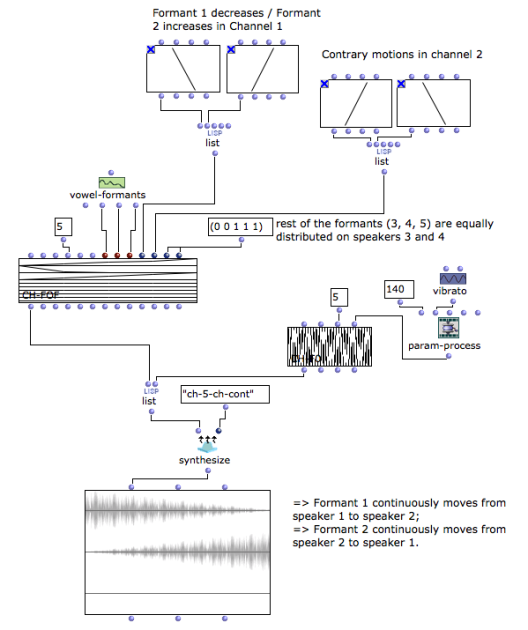Spatialization and Multi-Channel Control
The Chant synthesizer allows to create files with an arbitrary number of channels, and to determine the distribution of the FOF generators and filter bank outputs over these channels. This feature enables the control of the spatialization in synthesis processes with a "speaker-oriented" apporach.
As for the rest of the parameters, the control is done "per component" using the matrix structures : every individual FOF or filter can have a specific position or trajectory.
The channel control can be done at two complementary levels:
- Inside the events, that is, in the CH-FOF or CH-FILTER objects
- At the global level of the phrase, using specific channel controllers (CH-CHANNELS)
Channel Control in the Chant Events - The :chanX keywords
Multichannel control can be added to a Chant matrix event (CH-FOF or CH-FILTER) by adding the corresponding number of keyword controllers. [type k / K to add/remove a keyword controller to a CLASS-ARRAY object].
Get more info on the use of keyword controls in the CLASS-ARRAY in the OM User Manual : http://support.ircam.fr/docs/om/om6-manual/co/ClassArray.html
You can add as many control slots k as you like in the Chant objects (as in CLASS-ARRAY objects in general).
In order to make these control slots channel controllers for the Chant synthesizer, just name them :chanXXX. (for instance, :channel1, :channel2, etc.)
The number of channels in the output file will be the maximum number of :chanX keywords found in the Chant events.
In this example, two channel controls are added to the CH-FOF object. The 5 FOF will therefore be distributed on two channels accordingly.
| 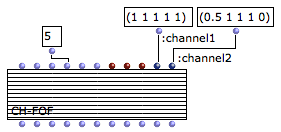 |
The tutorial patch "chant-channels" is a similar example with 5 channels where each FOF is directed to one specific channel.
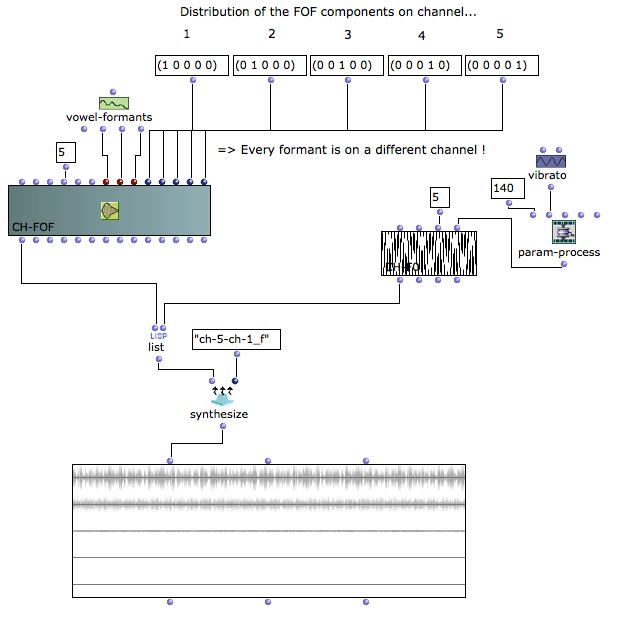
The multi-channel control can also be done in a continuous way using BPF objects instead of constant values.
Then, a BPF describes the evolution of the gain for a given FOF and a given channels. Continuous transitions of the FOF between one channel and another one (that is, between the different speakers in a given rendering setup) can therefore be impemented.
Global Multi-Channel Control : CH-CHANNELS
The object CH-CHANNELS is a special type of Chant event controlling the channel distribution globally and independently from the structure and contents of the CH-FOF or CH-Filter events. CH-CHANNELS behaves exactly the same as a standard Chant event and must be initialized with similar temporal attributes (action-time, duration), number of components (numcols), etc. | 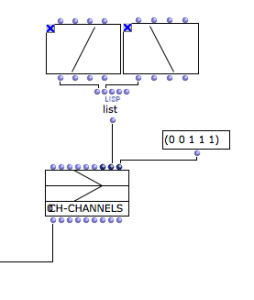 |
It is often more convenient to think of trajectories by components (FOF) rather than by channel. The function GEN-CHANT-CHANNELS automatically creates an instance of CH-CHANNELS from a list of timed distributions provided for each different component.
( ; formant 1 ((t0 (speaker1 speaker2 speaker3 speaker4)) (t1 (speaker1 speaker2 speaker3 speaker4)) ; ... (tn (speaker1 speaker2 speaker3 speaker4))) ; formant 2 ((t0 (speaker1 speaker2 speaker3 speaker4)) (t1 (speaker1 speaker2 speaker3 speaker4)) ; ... (tn (speaker1 speaker2 speaker3 speaker4))) ; ... ) | 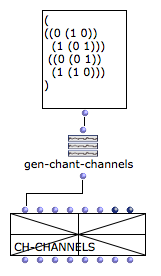 |
